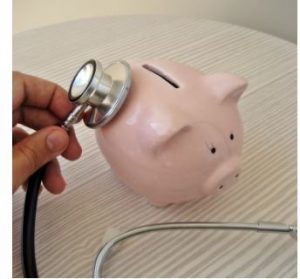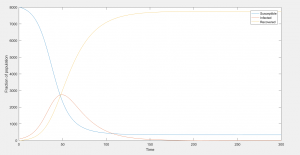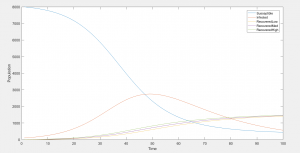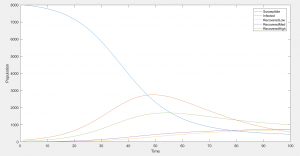
If the effect of socioeconomic statuses on the recovery rate of the flu is considered, a revised SIR model with different recovery rates for the various socioeconomic groups can be created.
The typical SIR model includes many assumptions, allowing for a simple model. Important assumptions in the SIR model are that the transmission and recovery rates are fixed constants. Other assumptions include all individuals are the same age, have the same number of contacts with infected people, and have the same socioeconomic status. When socioeconomic status and its effect on recovery rate is considered, an SIR model showing different recovery rates can be made.
One risk factor for influenza is asthma. People with asthma have a greater chance of facing complications from the flu (1). According to a study, socioeconomic status was found to be negatively associated with asthma (2). Low socioeconomic status individuals often live in urban areas and are exposed to both indoor and outdoor pollution, leading to increased chances of asthma (2). This is important in considering the SIR model since people with asthma will more likely have a slower rate of recovery compared to the average.
The rate of recovery from the flu is also affected by the amount of rest taken. Low socioeconomic status individuals are more likely to not take as many days off as those with higher status (3). Many in the low socioeconomic group are also less likely to receive medical care and attention (4). With more stress on the body, the time for recovery may increase.
Those with higher socioeconomic status have greater access to health care and are not restricted in terms of medical attention or care by money. In addition, they are more likely to take days off from work. This means that those with higher socioeconomic status will be more likely to recover from a disease at a faster rate.
According to the simple SIR model (Figure 1), all individuals are assumed to have the same recovery rate. However, a revised SIR model (Figure 2) that takes into consideration three different socioeconomic statuses can show the different recovery rates in the various groups over time. If the average recovery rate is 5% for those with medium socioeconomic status, assume that the recovery rate is 1% in the low category and 9% in the high category. The recovery population in the three socioeconomic groups are not drastically different, but with greater differences in the recovery rate, the more different the recovery populations will be (Figure 3).

Figure 1. SIR model under the assumption all people have the same recovery rate
S’ = – beta * S * I, I’ = beta * S * I- gammaMed*I, RLow= gammaLow*I, RMed = gammaMed *I, RHigh = gammaHigh *I

Figure 2. Revised SIR model with recovery rates associated with socioeconomic status
beta= 0.00002; gammaLow = 0.01; gammaMed= 0.05; gammaHigh = 0.09;

Figure 3. Revised SIR model with recovery rates associated with socioeconomic status
beta= 0.00002; gammaLow = 0.005; gammaMed = 0.05; gammaHigh =0.5;
Although the revised SIR model takes into consideration the categories of socioeconomic status, the model is still very simplified. Limitations include that there are only three categories, while realistically, people fall within the spectrum. Other factors that can affect the outbreak of a disease include age, number of interactions, and environmental factors, all of which are not considered in this model.
The SIR model is simply a model and cannot predict exact numbers, but the disparity between the socioeconomic groups should be taken into consideration when modeling diseases.
- “Flu and People with Asthma.” Centers for Disease Control and Prevention. Centers for Disease Control and Prevention, 25 Aug. 2016. Web. 04 Nov. 2016. <http://www.cdc.gov/flu/asthma/>.
- Bacon, Simon. “Individual-level Socioeconomic Status Is Associated with Worse Asthma Morbidity in Patients with Asthma.” Respiratory Research. BioMed Central, 2009. Web. 04 Nov. 2016. <https://respiratory-research.biomedcentral.com/articles/10.1186/1465-9921-10-125>.
- “Work, Stress, and Health & Socioeconomic Status.” American Psychological Association. APA, 2016. Web. 04 Nov. 2016. <http://www.apa.org/pi/ses/resources/publications/work-stress-health.aspx>.
- Adler, Nancy E.” Socioeconomic Disparities In Health: Pathways And Policies. “Project HOPE, 01 Mar. 2002. Web. 04 Nov. 2016. <http://content.healthaffairs.org/content/21/2/60.full>.
Selina Husain, Jasmine Pacheco-Ramos, Ayumi Mizuno